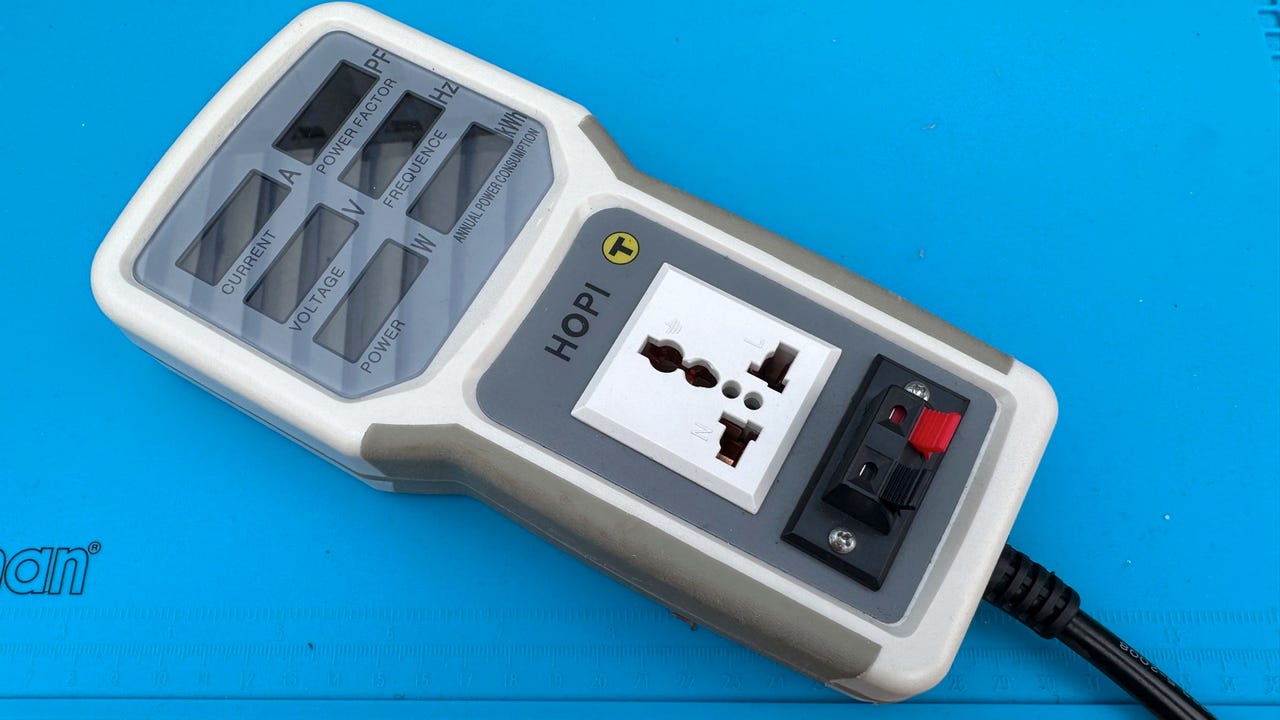What I use to measure device power consumption (and what you should use instead)

The Hopi HP-9800 power meter. Adrian Kingsley-Hughes/ZDNET
As part of my work, I test a lot of devices that are mains-powered (or wall-powered), and one of the tests I carry out is power consumption. I’ve had a lot of questions about the devices I use for this task, so here I’ll outline the tools I use, why I use then, why you probably shouldn’t use them, and what you should use instead.
There are a lot of different tools you can buy for measuing power consumption, ranging from very cheap to very expensive.
Also: The best power banks for recharging your devices
A few years ago, I picked up a Hopi HP-9800 meter from eBay. Its price ranges $50 to $70 (the cost seems to fluctuate daily), and while it’s now put in a few years of service, from a safety point of view, it’s a bit… lacking.
The socket — which is the type that accepts all sorts of plugs — features metalwork, which is live at mains voltage that could easily be touched, along with speaker connectors that have been repurposed as connectors that also have exposed bits live at mains voltage.
You could stick your fingers in here and touch live voltage. Adrian Kingsley-Hughes/ZDNET
These bits of metal are live at a quarter of a thousand volts. Adrian Kingsley-Hughes/ZDNET
Those speaker connectors also make it near impossible to fit a U.K. plug, so I have to use an adapter.
Some plugs don’t fit properly. Adrian Kingsley-Hughes/ZDNET
But I know the nature of the beast, take care when I’m using it, and unplug the device when done. One big plus point: that display is nice and clear, and easy to read (although a bit flickery when viewed through a camera).
Nice, clear display on the Hopi HP-9800. Adrian Kingsley-Hughes/ZDNET
The other day, I came across a new meter called the AnTai ATX.9801.
The AnTai ATX.9801 power meter. Adrian Kingsley-Hughes/ZDNET
I picked this tool up from AliExpress for around $50, and while it’s visually similar to the Hopi unit (I’m not sure if it’s an upgraded version, a clone, the original product, or something else), this device seems to be an upgrade.
Also: The best portable power stations you can buy
I find this unit works more reliably with some loads, and is much better from a safety point of view. For example, the socket has covers over the live metalwork, and the speaker connectors off the front are gone.
Shuttered safety socket on the AnTai ATX.9801. Adrian Kingsley-Hughes/ZDNET
Again, it has a nice, clear display.
Nice, clear display on the AnTai ATX.9801. Adrian Kingsley-Hughes/ZDNET
It’s a good unit — but, once again, it’s not something I’d leave plugged in unattended.
A much better option for most home users is a plug-in power meter.
Also: My favorite power bank for my MacBook Pro gets an upgrade
There are a lot of them on the market, and you can pick up a decent one for $15. I’ve tried and tested this one and it seems to do it all, including measuring power (W), energy consumption (kWh), volts, amps, power frequency, power factor, and minimum and maximum power usage (W).
And if you input how much your electricity costs per kWh, then this unit will show you real-time data on how much something is costing you to run.
This unit does it all — it measures power (W), energy (kWh), volts, amps, hertz, power factor, cost, and minimum and maximum power (W).
This meter also has additional features, such as overload protection and even a memory that retains power consumption data when unplugged. It’s a really good all-round power meter. It’s a great unit, and much safer for home users.
So, why do I continue to use my sketchy power meters? Bottom line is convenience — these units show everything I need to see on the display at once, without me needing to press buttons or flick between screens, and the socket will take anything I plug into it (as long as it’s not my fingers).
For all the latest Technology News Click Here
For the latest news and updates, follow us on Google News.
